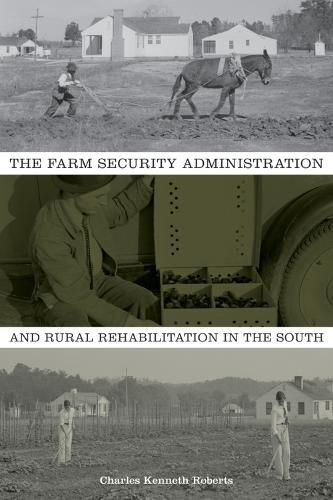Readings Newsletter
Become a Readings Member to make your shopping experience even easier.
Sign in or sign up for free!
You’re not far away from qualifying for FREE standard shipping within Australia
You’ve qualified for FREE standard shipping within Australia
The cart is loading…






As the roaring twenties turned into the depressed thirties, southern farmers, far removed from the urban prosperity Americans had enjoyed during the 1920s heyday, found already difficult farming conditions greatly intensified by the onset of the Great Depression. Agricultural incompetence plagued the rural South through the misuse of land, depletion of natural resources, and a system of single-crop farming that failed to adequately provide for growing families on small farms, especially in the cotton-producing Southeast. Poverty and desperation came to define the farming communities of the rural South, both in reality and in Americans’ collective conscious. In The Farm Security Administration and Rural Rehabilitation in the South, Charles Kenneth Roberts traces the administrative and political history of the Farm Security Administration (FSA) and reconciles the administration’s goals with Franklin D. Roosevelt’s overall vision for the New Deal. Roberts takes a grassroots approach to dissecting the FSA’s history. While other studies have focused on FSA photography or community building, or even policy making in terms of top-down government directives, Roberts focuses on the people and state governments who faced an immediate need to aid southern farmers within their own borders and to boost their states’ crumbling agricultural economic bases. Roberts focuses on rural rehabilitation as a key aspect of the FSA and defines the agency’s legacy not in terms of its failures but rather in terms of an idealistic program whose modest successes were ultimately too few to effect real change for southern farmers.
Though Roosevelt failed to adequately recognize the plight of the southern farmer and political infighting hindered many of the administration’s goals, the creation of the FSA stands as one of the first efforts to provide sustained relief to struggling southern farmers. In light of other federal programs of the era, the FSA may seem like a mere footnote to the New Deal outside of its small but revered photography program. But, as Roberts shows, the FSA’s legacy has endured to the present day.
$9.00 standard shipping within Australia
FREE standard shipping within Australia for orders over $100.00
Express & International shipping calculated at checkout
As the roaring twenties turned into the depressed thirties, southern farmers, far removed from the urban prosperity Americans had enjoyed during the 1920s heyday, found already difficult farming conditions greatly intensified by the onset of the Great Depression. Agricultural incompetence plagued the rural South through the misuse of land, depletion of natural resources, and a system of single-crop farming that failed to adequately provide for growing families on small farms, especially in the cotton-producing Southeast. Poverty and desperation came to define the farming communities of the rural South, both in reality and in Americans’ collective conscious. In The Farm Security Administration and Rural Rehabilitation in the South, Charles Kenneth Roberts traces the administrative and political history of the Farm Security Administration (FSA) and reconciles the administration’s goals with Franklin D. Roosevelt’s overall vision for the New Deal. Roberts takes a grassroots approach to dissecting the FSA’s history. While other studies have focused on FSA photography or community building, or even policy making in terms of top-down government directives, Roberts focuses on the people and state governments who faced an immediate need to aid southern farmers within their own borders and to boost their states’ crumbling agricultural economic bases. Roberts focuses on rural rehabilitation as a key aspect of the FSA and defines the agency’s legacy not in terms of its failures but rather in terms of an idealistic program whose modest successes were ultimately too few to effect real change for southern farmers.
Though Roosevelt failed to adequately recognize the plight of the southern farmer and political infighting hindered many of the administration’s goals, the creation of the FSA stands as one of the first efforts to provide sustained relief to struggling southern farmers. In light of other federal programs of the era, the FSA may seem like a mere footnote to the New Deal outside of its small but revered photography program. But, as Roberts shows, the FSA’s legacy has endured to the present day.